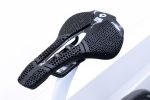Added comfort with new Prologo Scratch M5 PAS 3DMSS saddle
Italian cycling components brand Prologo has released a new version of its Scratch M5 PAS saddle, keeping the shape already trusted by professionals such as Jonas Vingegaard, Egan Bernal, Sepp Kuss, and Romain Bardet.
While the geometry remains unchanged, the main update lies in the saddle’s 3D printed cover, developed to improve comfort and pressure distribution without altering fit.
Named Scratch M5 PAS 3DMSS, the new model maintains its compact 250 x 140 mm profile and continues to use an injected long-fibre carbon base. This material is a standard across Prologo’s performance line, valued for its balance of low weight, rigidity, and compliance.
The Scratch M5 PAS 3DMSS saddle. Photo via Prologo.
Manufacturing approach for Scratch M5 PAS 3DMSS
For this version, the Italian brand has used 3D printing to produce the upper surface. According to BikeRumor, Prologo’s Multi Sector System (MSS) was combined with digital light projection, oxygen-permeable optics, and engineering-grade resins. Doing so enabled precise structural variation across the saddle surface, although the 3D printer brand has not been disclosed.
According to CyclingWeekly, the 3D printed surface follows the MSS layout, dividing the saddle into three main zones: front, center, and rear. Each zone is constructed from two layers with varying geometries and densities to better support different areas of the rider’s body.
The rear is shaped to stabilize the sit bones during power efforts. The center aims to relieve pressure on softer tissues. Toward the front, the structure supports riders who shift forward during climbs or sprints.
Development of the layout was informed by pressure mapping through Prologo’s MyOwn fitting system. Data collected from both professional and amateur cyclists helped shape how each zone of the saddle responds during different phases of pedaling.
A central channel, known as the Perineal Area System (PAS), remains part of the design. It is intended to reduce numbness by relieving pressure through the center and improving blood flow over longer rides.
The Italian company has made two rail options available. Weighing 176 g, the lighter version features Nack rails made from carbon fiber reinforced with Kevlar and aluminum filaments. The second version, using light alloy Tirox rails, weighs 209 g. Retail pricing is set at €390 and €290 respectively, with availability expected from May.
A close up look at the 3D printed saddle. Photo via Prologo.
3D printing comfortable cycle saddles
Whether a beginner or a professional, every cyclist knows the importance of having a comfortable saddle. And with 3D printing, this has become increasingly possible.
In 2022, US-based cycling equipment manufacturer Fizik launched the Argo Adaptive, its novel 3D printed short-nose saddle, at the Sea Otter cycling show. Produced using Carbon’s Digital Light Synthesis (DLS) 3D printing technology, the saddle featured a tuned lattice cushioning designed to improve comfort and rider stability.
The Argo Adaptive followed the earlier Antares Adaptive model and continued Fizik’s partnership with Carbon under its ‘Concepts’ innovation initiative. Offered in 140mm and 150mm widths, the saddle was made available in two versions: the carbon-railed R1 and the steel alloy-railed R3, which at the time were priced at $299 and $259 respectively.
One year before that, German design firm DQBD used Stratasys’ launched H350 3D printer, powered by Selective Absorption Fusion (SAF) technology, to produce fully personalized cycling saddles. The SAM saddle featured a semi-rigid, 3D printed PA11 spine and a thermoformed seat pad, customized using rider-specific pressure mapping data.
By adopting Stratasys’ SAF technology, DQBD reduced production costs by up to £22,000 and cut lead times from six months to ten days compared to traditional injection molding. The glue-less assembly also allowed for easier recycling, while offering riders enhanced comfort, support, and reduced fatigue.
What 3D printing trends should you watch out for in 2025?
How is the future of 3D printing shaping up?
To stay up to date with the latest 3D printing news, don’t forget to subscribe to the 3D Printing Industry newsletter or follow us on Twitter, or like our page on Facebook.
While you’re here, why not subscribe to our Youtube channel? Featuring discussion, debriefs, video shorts, and webinar replays.
Featured image shows the Scratch M5 PAS 3DMSS saddle. Photo via Prologo.


